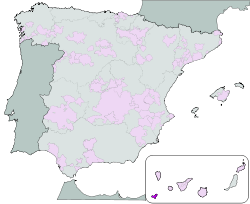
Calatayud is a Spanish Denominación de Origen Protegida (DOP) for wines located in the southwestern corner of the province of Zaragoza about 90 km from Zaragoza and covers over 5,600 ha, extending over 46 different municipalities, including Calatayud itself. It borders with the Cariñena (DO) in the east and with the province of Soria in the west. It is in the Ebro River valley and is crisscrossed by many of the Ebro's tributaries including the Jalón, Jiloca, Manubles, Mesa (river), Piedra and Ribota. The vineyards are found on the south facing slopes of the Sierra de la Virgen range at heights of between 550 m and 800 m above sea level.

Almansa is a Spanish Denominación de Origen Protegida (DOP), known for its red wines, located in the southeast of the province of Albacete, in the transition zone between the high central plateau and the Mediterranean Sea. The vineyards are mostly around the towns of Almansa, Alpera, Bonete, Corral-Rubio, Higueruela, Hoya-Gonzalo, Pétrola and El Villar de Chinchilla.

Costers del Segre is a Spanish Denominación de Origen Protegida (DOP) for wines located in the province of Lleida and is divided into several separate sub-zones. The four original subzones created in 1988 are Artesa, to the northeast of Lleida, Valls de Riucorb to the east, Garrigues and Raïmat. In 1998 two other subzones were added: Pallars Jussà, next to the town of Tremp, 90 km north of Lleida and Segrià to the west and surrounded by the Raimat subzone.

Pla de Bages is a Spanish Denominación de Origen Protegida (DOP) for Catalan wines, located in the province of Barcelona, and is one of the smallest DOPs in Spain, covering less than 500 hectares. It is also one of the newest having acquired its official status in 1997.

Tarragona is a Spanish Denominación de Origen Protegida (DOP) for Catalan wines, located in the province of Tarragona and covers two distinct areas: the Camp de Tarragona and the Ribera d'Ebre comarca (district).

Valencia is a Spanish Denominación de Origen Protegida (DOP) for wines located in the Province of Valencia within the Valencian Community and is divided into two separate zones and four sub-zones, each of which produces a different type of wine.

Navarra is a Spanish Denominación de Origen Protegida (DOP) for wines from the southern half of the autonomous community of Navarre. The vineyards are on the lower slopes of the Pyrenees as they descend towards the basin of the river Ebro.

Binissalem is a Spanish Denominación de Origen Protegida (DOP) for wines located around the town of Binissalem in the centre of the island of Majorca,.

Pla i Llevant is a Spanish Denominación de Origen Protegida (DOP) for wines located on the island of Majorca, Balearic Islands, Spain. The name in the Catalan or Majorcan language means "plain and east coast."

Tacoronte-Acentejo is a Spanish Denominación de Origen Protegida (DOP) for wines located in the Anaga Peninsula on the northeastern coast of the island of Tenerife. It was the first region in the Canary Islands to acquire DO status, in 1992. It covers the municipalities of Santa Cruz de Tenerife, San Cristóbal de La Laguna, El Rosario, Tegueste, Tacoronte, El Sauzal, La Matanza de Acentejo, La Victoria de Acentejo and Santa Úrsula.

Abona is a Spanish Denominación de Origen Protegida (DOP) for wines located on the southern coastline of Tenerife,, and acquired its DO in 1996.

Valle de Güímar is a Spanish Denominación de Origen Protegida (DOP) for wines located along the south-eastern coastline of Tenerife, and acquired its DO in 1996.

Valle de la Orotava is a Spanish Denominación de Origen Protegida (DOP) for wines located on the north-western coastline of Tenerife,, and acquired its DO in 1995.

Ycoden-Daute-Isora is a Spanish Denominación de Origen Protegida (DOP) for wines located in the western part of the island of Tenerife. It acquired its DO status in 1994.

La Gomera is a Spanish Denominación de Origen Protegida (DOP) for wines that covers the entire island of La Gomera comprising the six municipalities of San Sebastián de la Gomera, Hermigua, Agulo, Vallehermoso, Valle Gran Rey and Alajeró. It obtained its official status in 2009.

Gran Canaria is a Spanish Denominación de Origen Protegida (DOP) that covers the entire island of Gran Canaria comprising 21 municipalities. It obtained its official status in 2009.

La Palma is a Spanish Denominación de Origen Protegida (DOP) for wines that covers the entire island of La Palma, in the Canary Islands, Spain. It acquired its DO in 1994. There are around 600 ha of vineyards registered with the DOP, planted in a strip along the coast, though the altitude can vary between 200 m and 1,500 m above sea-level. The DOP is divided into three sub-zones.

Lanzarote is a Spanish Denominación de Origen Protegida (DOP) for wines that covers the entire island of Lanzarote, in the Canary Islands, Spain. It acquired its DO in 1994, and there are currently around 1,800 ha under cultivation.

Listán Negro is a red Spanish wine grape variety that is widely planted in the Canary Islands, particularly on the island of Tenerife where it is a permitted variety in the Denominaciones de Origen (DO) wines of Tacoronte-Acentejo, Valle de la Orotava, Ycoden-Daute-Isora, and Valle de Güímar. It is also permitted in the Spanish wine regions of El Hierro, Gran Canaria, La Gomera, La Palma, Lanzarote. More than 5,000 hectares of the Listán Negro grape variety are planted across the Canary Islands.
Islas Canarias is a Spanish Denominación de Origen Protegida (DOP), traditionally called a Vino de calidad con Indicación Geográfica. This is one step below the mainstream Denominación de Origen quality wines and one step above the less stringent Vino de la Tierra wines on the quality ladder. It is encompasses all the Canary Islands. The Canary Islands also has ten individual DO's.





















